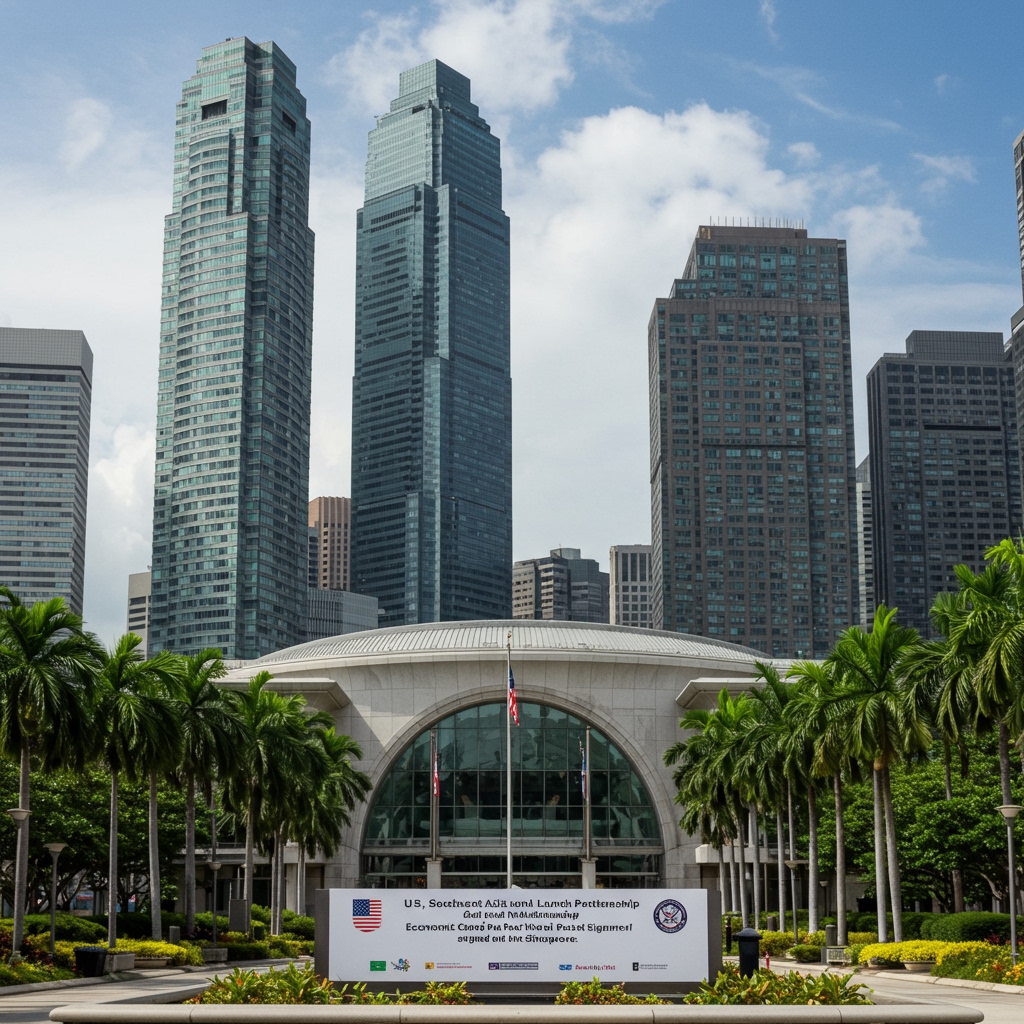US, Southeast Asia Finalize Landmark Indo-Pacific Economic Partnership (IPEP) Agreement
SINGAPORE – In a significant step bolstering economic ties across the Indo-Pacific region, officials from the United States and the ten-member Southeast Asian Coalition (SEAC) successfully finalized the Indo-Pacific Economic Partnership (IPEP) agreement. The historic signing ceremony took place in Singapore on February 22, 2025, marking the culmination of intensive negotiations aimed at fostering deeper economic integration and cooperation. The comprehensive pact is designed to address key challenges and opportunities in the 21st-century economy, focusing on reducing trade barriers, boosting digital commerce cooperation, and accelerating clean energy technology investment.
Pillars of the IPEP Agreement
The IPEP agreement is structured around several key pillars, moving beyond traditional free trade agreements to tackle modern economic complexities. One central tenet is the commitment to reduce trade barriers. While not eliminating tariffs, the agreement focuses on streamlining customs procedures, enhancing regulatory coherence, and promoting trade facilitation measures that can significantly lower the cost and time associated with cross-border commerce. This aspect is particularly crucial for improving the efficiency of trade flows between the United States and the SEAC member nations.
Another vital component is the emphasis on boosting digital commerce cooperation. Recognizing the growing importance of the digital economy, the pact includes provisions aimed at facilitating cross-border data flows, ensuring consumer protection in online transactions, and promoting interoperability of digital systems. It also encourages cooperation on digital infrastructure development and cybersecurity, creating a more secure and interconnected digital environment for businesses and consumers alike. This pillar is seen as essential for unlocking the full potential of digital trade in the rapidly expanding Southeast Asian markets.
Furthermore, the IPEP agreement places a strong focus on environmental sustainability and the transition to cleaner energy sources. The commitment to accelerate clean energy technology investment aims to mobilize capital towards renewable energy projects, energy efficiency initiatives, and the development of sustainable infrastructure. This includes potential cooperation on carbon markets, green finance standards, and the deployment of innovative clean technologies. This pillar aligns with global efforts to combat climate change while simultaneously creating new economic opportunities in green industries. Sustainable infrastructure is explicitly mentioned as one of the key sectors expected to benefit.
Enhancing Supply Chain Resilience and Economic Impact
A critical objective woven throughout the agreement is the enhancement of supply chain resilience. Recent global disruptions have highlighted the vulnerabilities in complex international supply chains. The IPEP pact seeks to address this by establishing mechanisms for identifying supply chain vulnerabilities, coordinating responses to disruptions, and promoting diversification of sourcing and production locations. This focus is particularly relevant for key sectors like electronics and manufacturing, which have deeply integrated supply chains spanning the United States and Southeast Asia. By working together, partners aim to build more robust and reliable supply networks, reducing risks for businesses and ensuring the steady flow of goods.
Experts evaluating the potential impact of the IPEP agreement have released optimistic forecasts. Initial estimates suggest the deal could generate over $500 billion in new trade and investment over the next five years. This substantial economic boost is anticipated across various sectors, notably including electronics, manufacturing, and sustainable infrastructure. The predicted increase in trade and investment is expected to stimulate economic growth, create jobs, and foster innovation across the participating economies. The comprehensive nature of the agreement, addressing both traditional trade facilitation and forward-looking areas like digital and green economies, contributes to this positive outlook.
Strategic Significance and Official Endorsements
Beyond its immediate economic benefits, the IPEP agreement carries significant strategic weight. It underscores the United States’ commitment to deeper engagement in the Indo-Pacific region and its recognition of SEAC’s crucial role in regional stability and prosperity. For the ten-member Southeast Asian Coalition, the partnership provides a platform for enhancing economic integration with a major global economy, attracting investment, and collaborating on critical issues like digital transformation and climate action. The pact is viewed as a cornerstone for fostering a more resilient, connected, and prosperous Indo-Pacific.
The agreement was formally signed by U.S. Secretary of Commerce Jane Doe and the SEAC Economic Ministers during the ceremony in Singapore. Both sides emphasized the collaborative spirit of the negotiations and the shared vision for the future. Secretary Doe highlighted the pact’s potential to drive innovation and create high-paying jobs in the United States while simultaneously supporting sustainable and inclusive growth in Southeast Asia. The SEAC Economic Ministers echoed these sentiments, stressing the importance of the partnership for enhancing enhanced supply chain resilience and promoting shared economic prosperity across the region. They underscored the agreement’s role in building a stable and predictable economic environment essential for long-term investment and trade growth.
Looking Ahead: Implementation and Collaboration
The finalization of the IPEP agreement represents a major milestone, but the focus now shifts to implementation. The participating countries will need to undertake necessary domestic procedures to bring the agreement fully into force. Moving forward, working groups and joint committees are expected to be established to oversee the execution of the agreement’s various provisions, monitor progress, and address any arising issues. Continued dialogue and cooperation will be essential to ensure the pact delivers on its promise of generating substantial new trade and investment, bolstering supply chains, and advancing cooperation in critical sectors like digital commerce and clean energy. The successful collaboration leading to the signing in Singapore provides a strong foundation for this ongoing partnership, aiming to shape a more prosperous and resilient economic future for the Indo-Pacific region.





